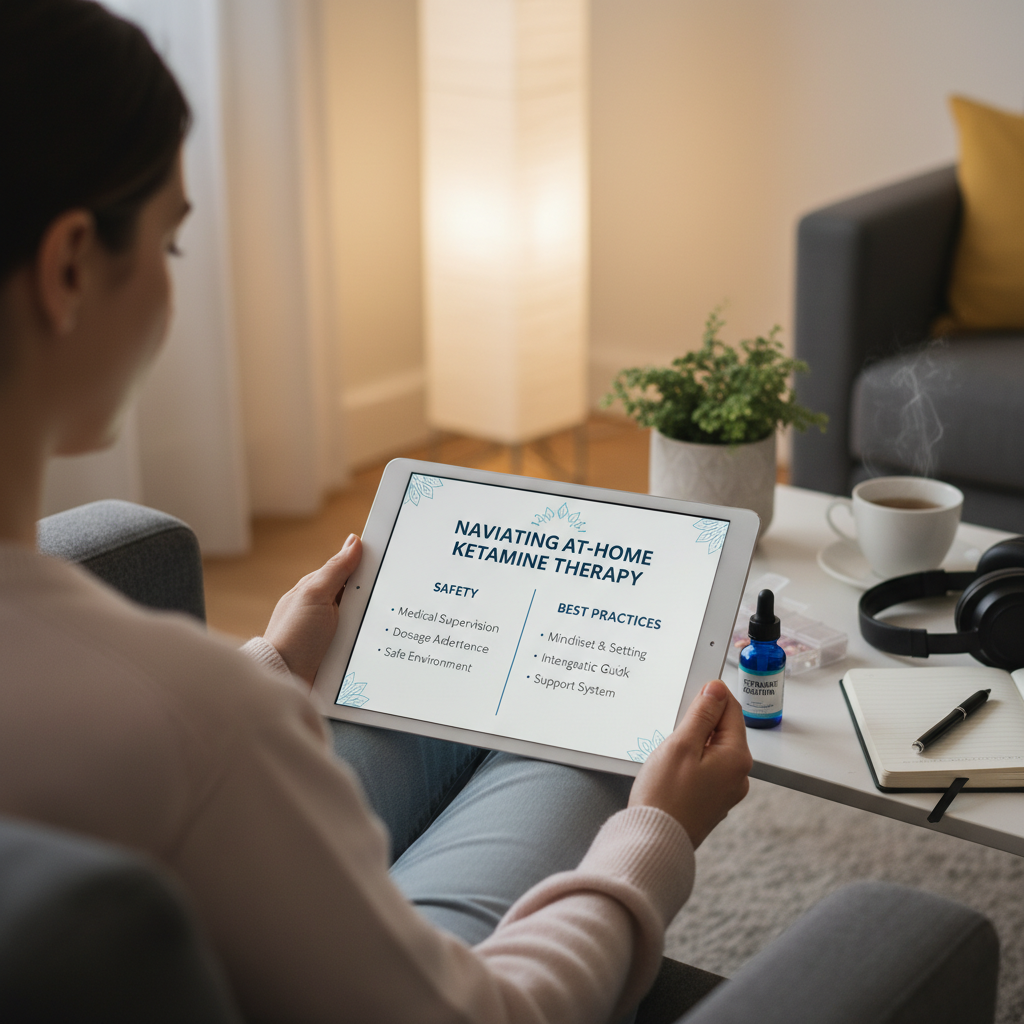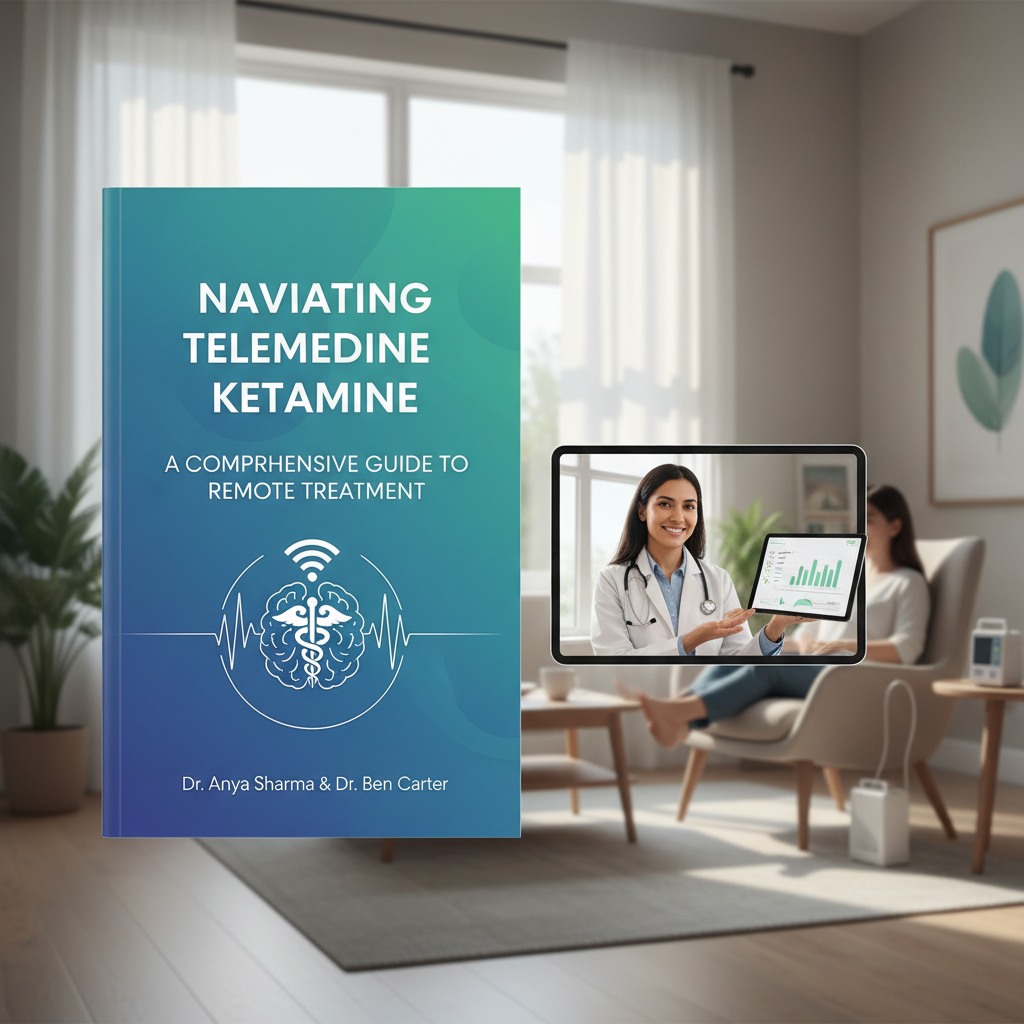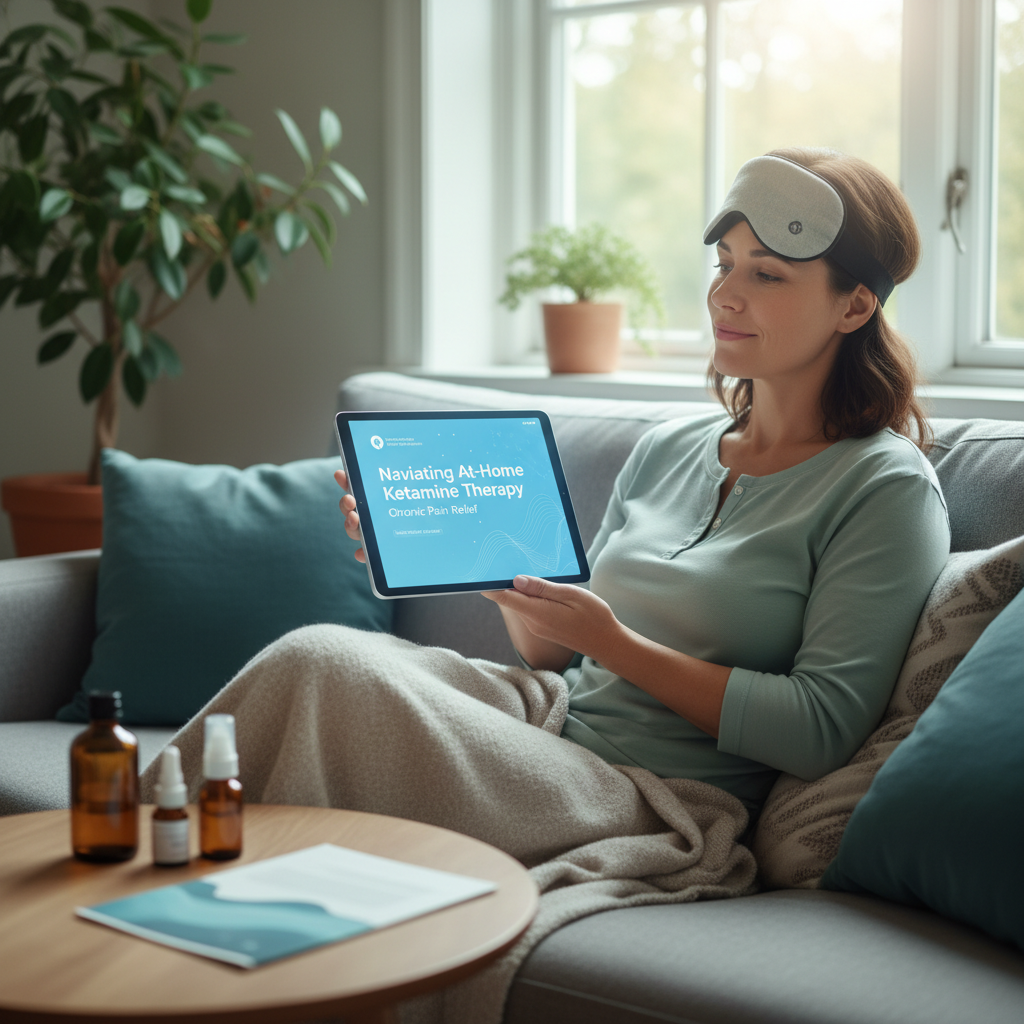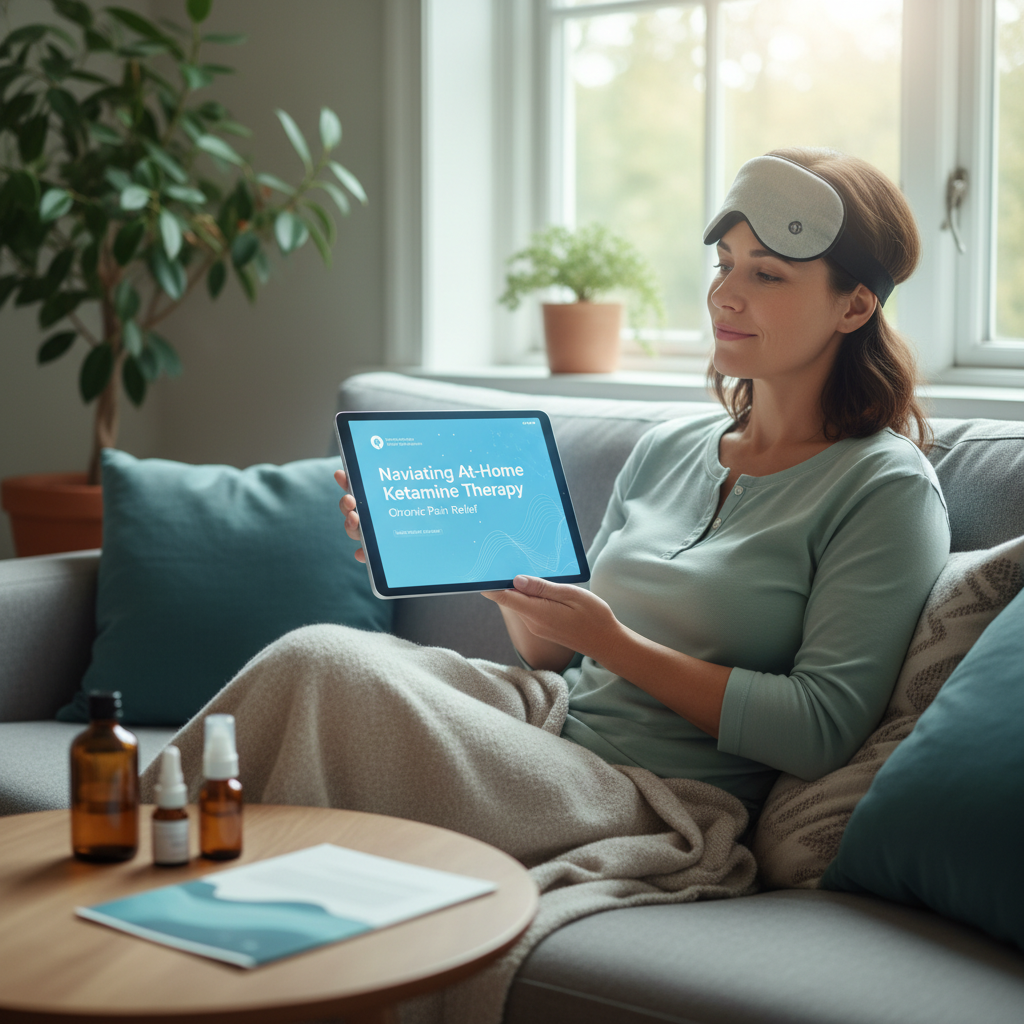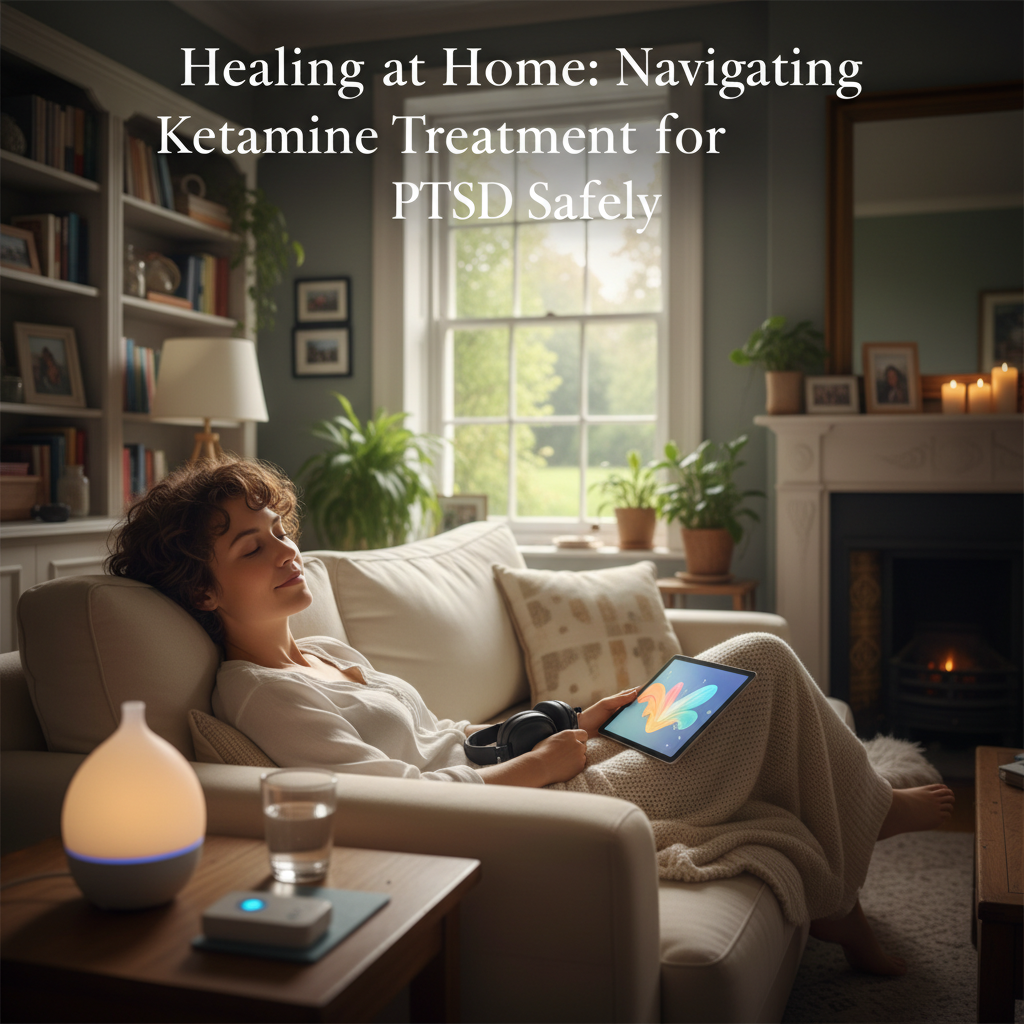Your Essential Guide to Secure and Effective At-Home Ketamine Treatment
Quick Summary / Key Takeaways
- Medical Oversight is Paramount: Always receive at-home ketamine therapy under strict medical supervision from a licensed provider for dosage, monitoring, and emergency protocols.
- Environment Matters: Prepare a safe, quiet, and comfortable setting free from distractions, ideally with a trusted sober sitter present, to enhance therapeutic benefit and reduce risks.
- Understand Potential Effects: Familiarize yourself with common side effects, how to manage them, and clear instructions for when to seek immediate medical attention.
- Strict Adherence to Protocol: Follow your prescriber’s exact dosage, frequency, and administration instructions without deviation. Never self-adjust your treatment plan.
- Integration is Key to Lasting Change: Combine at-home ketamine sessions with ongoing psychotherapy or mental health support to process insights and integrate changes for sustained well-being.
Introduction
Ketamine, once known primarily as an anesthetic, has emerged as a promising treatment for severe depression, anxiety, and PTSD. Its rapid antidepressant effects have sparked a revolution in mental health care, making it a beacon of hope for many. As treatment models evolve, at-home ketamine therapy, administered under medical supervision, offers unparalleled accessibility and comfort. However, this convenience comes with a critical caveat: safety. Administering a powerful medication like ketamine in a home setting demands stringent protocols, informed patient responsibility, and robust medical oversight. The success of at-home ketamine therapy hinges not just on its efficacy, but on the unwavering commitment to patient safety and well-being. This guide delves into the essential safety measures, considerations, and best practices for navigating at-home ketamine treatment. We’ll explore how to minimize risks, optimize your therapeutic environment, and ensure your journey toward healing is as secure as it is transformative. Your safety is paramount, and understanding these elements is your first step.
At-Home vs. Clinic Ketamine Safety Comparison
| Feature | At-Home Treatment | Clinic Treatment | Safety Implication |
|---|---|---|---|
| Supervision Level | Remote virtual monitoring | On-site medical staff, immediate response | Higher risk if not properly supported |
| Environment Control | Personal, familiar setting | Clinical, controlled atmosphere | Requires personal responsibility for safety |
| Emergency Response | Via designated contact, 911 | Immediate medical intervention available | Critical for managing adverse reactions |
| Preparation Effort | Significant patient setup needed | Minimal patient preparation | Pre-session setup impacts safety directly |
Common Ketamine Side Effects & Management Strategies
| Side Effect | Description | At-Home Management | When to Seek Help |
|---|---|---|---|
| Nausea/Vomiting | Mild to moderate stomach upset | Light meal before, anti-emetic meds | Persistent, severe vomiting, dehydration |
| Dizziness/Dissociation | Feeling ‘light’ or detached from body | Lying down, secure environment, sitter | Extreme disorientation, panic attacks |
| Increased Heart Rate | Temporary rise in pulse and BP | Relaxation techniques, slow movements | Sustained high BP, chest pain, discomfort |
| Anxiety/Panic | Feeling restless, fearful, overwhelmed | Grounding techniques, verbal reassurance | Severe, unmanageable panic, loss of control |
Application Preparation Checklist
- Confirm your medical provider is licensed for ketamine treatment.
- Ensure a trusted, sober sitter is present for the entire session.
- Prepare a quiet, safe, and comfortable space with no distractions.
- Have emergency contact information readily accessible, including 911.
Post-Arrival Checklist
- Process your experience with a mental health professional after each session.
- Reflect on insights gained and how to apply them to daily life.
- Stay hydrated and nourished, prioritizing self-care practices.
- Schedule follow-up appointments promptly for continued monitoring and support.
Table of Contents
Section 1: Foundations of Safe At-Home Ketamine Therapy
- Is at-home ketamine therapy truly safe for mental health conditions?
- What kind of medical supervision is required for at-home ketamine?
- How does a medical professional assess eligibility for at-home ketamine?
- What are the crucial legal and ethical considerations for this treatment?
- What’s the role of a “sitter” during at-home ketamine sessions?
Section 2: Preparing Your Environment and Mindset
- How should I prepare my home environment for a ketamine session?
- What steps can I take to ensure my physical safety during the session?
- How can I mentally prepare for the dissociative effects of ketamine?
- What should I do if I experience unexpected or adverse reactions?
- Are there specific medications or substances to avoid before treatment?
Section 3: Post-Session Care, Integration, and Long-Term Safety
- What is “integration” and why is it important after a ketamine session?
- How long do the effects of at-home ketamine last, and when can I resume normal activities?
- What are the long-term safety considerations for ongoing ketamine use?
- How do I communicate effectively with my provider about my experiences?
- When should I consider discontinuing or adjusting my at-home ketamine treatment?
Frequently Asked Questions
Section 1: Foundations of Safe At-Home Ketamine Therapy
FAQ 1: Is at-home ketamine therapy truly safe for mental health conditions?
Yes, at-home ketamine therapy can be safe for mental health conditions when administered under strict medical supervision and adherence to established protocols. This includes thorough patient screening, remote monitoring during sessions, and clear emergency procedures. Patients must also commit to preparing a secure environment and having a trusted individual present for support. Deviating from these guidelines significantly increases potential risks and compromises safety.
FAQ 2: What kind of medical supervision is required for at-home ketamine?
At-home ketamine therapy requires comprehensive medical supervision, typically involving telehealth consultations, remote monitoring, and a readily available medical team. A licensed provider conducts initial assessments, prescribes medication, and reviews progress, ensuring the patient’s vitals and psychological state are tracked during sessions. They also establish clear communication channels for immediate support and emergency response, ensuring that professional guidance is always accessible. This oversight is crucial for minimizing risks and maximizing therapeutic benefit.
FAQ 3: How does a medical professional assess eligibility for at-home ketamine?
Medical professionals assess eligibility for at-home ketamine through a comprehensive evaluation, including psychiatric history, physical health, and current medications. This typically involves detailed interviews, physical examinations, and sometimes lab tests to rule out contraindications like uncontrolled hypertension or severe cardiovascular disease. They also evaluate the patient’s support system and home environment to ensure it’s conducive to safe treatment. The goal is to identify individuals who can safely and effectively benefit from this unique treatment modality.
FAQ 4: What are the crucial legal and ethical considerations for this treatment?
Legal and ethical considerations for at-home ketamine treatment revolve around informed consent, patient autonomy, and responsible prescribing practices. Providers must ensure patients fully understand the treatment’s benefits, risks, and alternatives, obtaining explicit consent for at-home administration. Ethical guidelines also mandate rigorous patient selection, continuous monitoring, and accessible emergency care to mitigate risks inherent in home-based powerful medication. Adherence to state and federal regulations regarding controlled substances is paramount for both providers and patients.
FAQ 5: What’s the role of a “sitter” during at-home ketamine sessions?
A “sitter” plays a crucial supportive and safety monitoring role during at-home ketamine sessions, ensuring the patient’s physical safety and emotional comfort. This trusted individual, who must be sober and responsible, helps maintain a safe environment, assists with basic needs like getting a blanket, and monitors for any concerning physical or psychological changes. They are the primary point of contact for the medical team and are responsible for initiating emergency protocols if needed. Their presence adds a vital layer of protection and reassurance.
Section 2: Preparing Your Environment and Mindset
FAQ 6: How should I prepare my home environment for a ketamine session?
Preparing your home environment for a ketamine session involves creating a quiet, comfortable, and distraction-free space to maximize safety and therapeutic benefit. Ensure the room is tidy, dimly lit, and free from potential hazards, with comfortable seating or a bed available for lying down. Silence phones, turn off notifications, and inform household members not to disturb you to minimize interruptions. Some patients find a blindfold and headphones with calming music helpful for deepening the experience.
FAQ 7: What steps can I take to ensure my physical safety during the session?
To ensure physical safety during an at-home ketamine session, it’s vital to have a sober adult present, remove all tripping hazards, and remain in a comfortable, reclined position. Keep a glass of water nearby and a bucket in case of nausea, ensuring easy access to a bathroom before the session begins. Avoid eating heavy meals beforehand to minimize gastrointestinal discomfort. Always have your emergency contact information and the medical provider’s number readily available for your sitter.
FAQ 8: How can I mentally prepare for the dissociative effects of ketamine?
Mentally preparing for ketamine’s dissociative effects involves understanding that the experience can be unusual and sometimes intense, but generally temporary and safe. Engage in pre-session mindfulness or meditation to calm your mind and set a positive intention for the session. Remind yourself to “lean into” the experience without resistance, trusting the process and the support system in place. Open communication with your provider about anxieties beforehand can also provide reassurance and coping strategies.
FAQ 9: What should I do if I experience unexpected or adverse reactions?
If you experience unexpected or adverse reactions during an at-home ketamine session, the immediate step is to communicate with your sober sitter, who should then contact your medical provider as per your emergency plan. Remain calm and focus on your breathing, allowing your sitter to assess the situation and follow their instructions. In cases of severe reactions like chest pain, extreme difficulty breathing, or unmanageable panic, the sitter should call emergency services (911) immediately. Having a pre-established plan with your provider is crucial.
FAQ 10: Are there specific medications or substances to avoid before treatment?
Yes, specific medications and substances should be avoided before at-home ketamine treatment to prevent adverse interactions and ensure safety. Alcohol and illicit drugs are strictly prohibited, as they can dangerously potentiate ketamine’s effects or cause unforeseen complications. You should also discuss all prescription and over-the-counter medications, as well as supplements, with your provider during your screening. Benzodiazepines, in particular, may blunt ketamine’s therapeutic effects and should often be tapered or avoided before sessions as advised by your doctor.
Section 3: Post-Session Care, Integration, and Long-Term Safety
FAQ 11: What is “integration” and why is it important after a ketamine session?
“Integration” refers to the crucial process of processing, understanding, and incorporating the insights and experiences gained during a ketamine session into your daily life. It’s important because ketamine often creates a temporary window of neuroplasticity and allows for new perspectives, but without conscious effort, these insights may fade. Engaging in integration, often with the help of a therapist or coach, helps solidify new thought patterns, develop coping mechanisms, and translate the session’s revelations into lasting positive change. It transforms a temporary experience into sustained personal growth.
FAQ 12: How long do the effects of at-home ketamine last, and when can I resume normal activities?
The acute dissociative effects of at-home ketamine typically last 45-90 minutes, while residual effects like mild dizziness or altered perception can persist for several hours. You should not drive, operate heavy machinery, or make important decisions for at least 12-24 hours post-session, or until you feel completely clear-headed and stable. Your provider will give specific guidance based on your dosage and individual response. Always err on the side of caution and prioritize rest and reflection immediately after treatment.
FAQ 13: What are the long-term safety considerations for ongoing ketamine use?
Long-term safety considerations for ongoing ketamine use primarily involve potential urinary tract issues, cognitive impacts, and the risk of dependence, though these are rare with medical supervision. Consistent monitoring of kidney and bladder health is essential, especially with higher cumulative doses. Cognitive function is typically unaffected at therapeutic doses, but ongoing assessment helps ensure sustained well-being. Adherence to prescribed dosages and regular check-ins with your provider are key to mitigating these potential risks and maintaining a safe treatment trajectory.
FAQ 14: How do I communicate effectively with my provider about my experiences?
Communicating effectively with your provider about your at-home ketamine experiences involves being honest, detailed, and proactive in sharing both positive insights and any challenges. Keep a journal of your thoughts, feelings, and physical sensations during and after each session to provide concrete details. Don’t shy away from discussing difficult or unexpected experiences, as these can be crucial for treatment adjustment. Regular, scheduled follow-ups are vital opportunities to review your progress and address any concerns openly.
FAQ 15: When should I consider discontinuing or adjusting my at-home ketamine treatment?
You should consider discontinuing or adjusting your at-home ketamine treatment when advised by your medical provider, or if you experience persistent adverse effects that outweigh the benefits. Other reasons include achieving stable remission from your condition, or if the treatment is no longer providing significant therapeutic value. Never self-adjust or abruptly stop ketamine treatment without consulting your doctor, as this can lead to withdrawal symptoms or a relapse of your mental health condition. Your provider will guide a safe tapering plan if cessation is appropriate.


